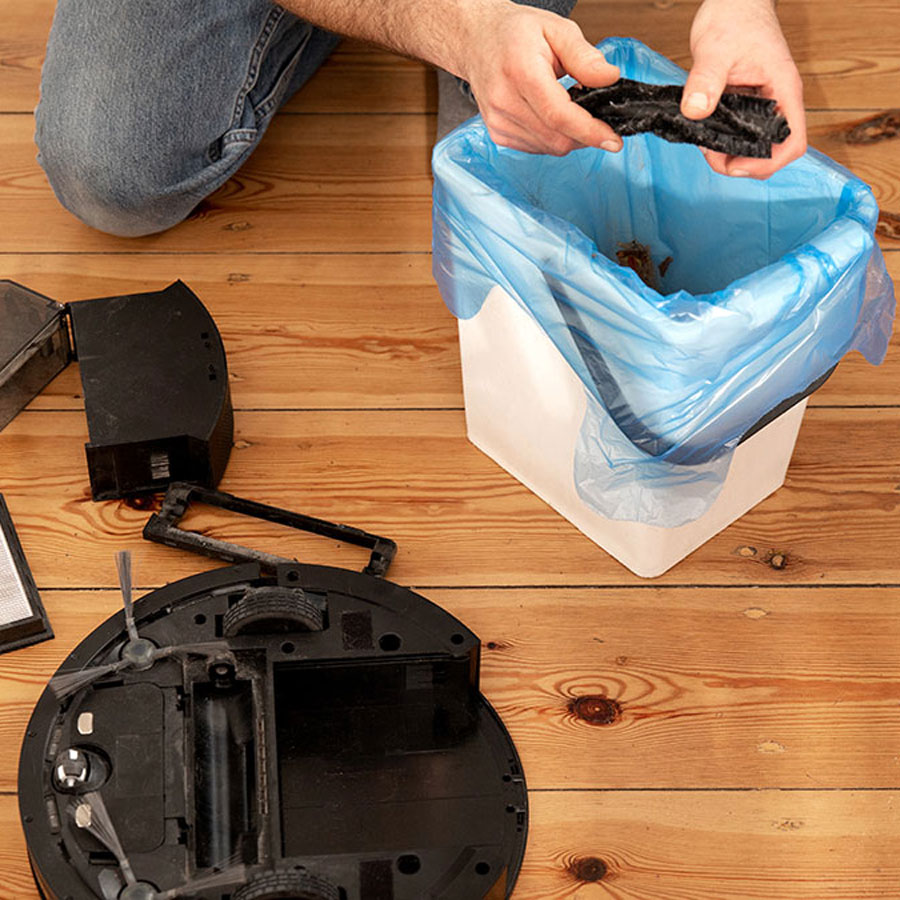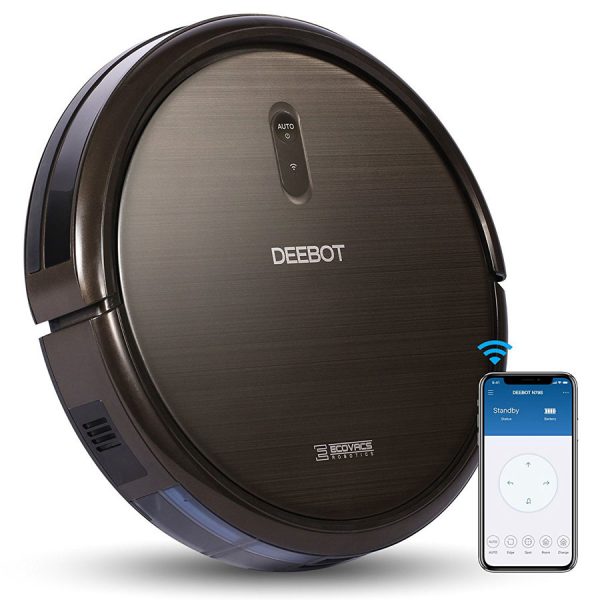How to clean a robot vacuum is essential knowledge for anyone owning the appliance. Unfortunately, robot vacs can’t yet clean themselves.
You must take regular, timely care of your robot vac to prolong its lifespan and maintain its cleaning efficiency.
A robot vac with hair tangled around brushes and wheels and a full dustbin won’t suck in debris nearly as effectively as a clean appliance. Fortunately, cleaning a robot vac is easier than it seems.
Get ready a soft dry cloth, a trash can, and, possibly, a screwdriver. You might also need scissors, a mail opener, or a special brush-cleaning tool to remove tangled hair.
Cleaning each component of the vac is time-consuming, but you don’t have to do it every time. Most importantly, you should regularly empty the dustbin and replace the filter.
Empty the Dustbin
The first step in cleaning a robot vacuum is emptying the dustbin. If you wonder how to empty a robot vacuum dustbin, I advise you to first check the user manual for your specific model because the instructions may vary.
If you’ve lost the user manual, here’s how to empty the dustbin on Roomba Series “e,” “i,” and “j.” Start by pressing the release button on the vac’s back. Then, the bin will slip out of the vacuum.
Prepare the trash can and hold the dustbin above it. Press the bin door release button marked by a trash icon and empty the container. Turn your face away to avoid breathing in dust, dander, and other debris.
Now, rinse the dirt bin to remove the remaining debris and allow it to air-dry or wipe it with a paper towel. Lock the dustbin back, and you’re ready.
The process is similar with Roomba 600 Series, but the dustbin isn’t washable because it contains part of the motor. Roomba s9 and s9+ have different dustbin shapes and placements – you need to open the top door to access the container.
Further steps are no different. If your Roomba has a self-emptying base, you don’t need to clean the dustbin of the vac but only empty the dock when it gets full.
Overall, the process is similar for most robot vac brands and models. The dustbin door placement might vary, but there’s usually an indicator like a trash icon or a variation.
For example, Dyson 360 Heurist has a quick-release button on the top. Xiaomi robot vacs, too, open from the top.
Clean Roller Brushes
Most robot vacs have a large, bristled roller brush that collects long hair and debris, quickly losing effectivity if you don’t clean it properly. First, open the brush guard, preferably on a towel or above the trash bin.
Now, remove the brushes. You’ll see plastic bearings at the end of each brush – remove them too. Pull off any hair wrapped around the bearings or tucked under them.
You’ll need to spend some time yanking and pulling tangled hair from the actual bristles. You can use a mail opener or a knife to ease the process.
If you have a brush cleaning tool that looks like a ring with dozens of teeth, by all means, use it – that will save you a lot of time. Pull the brush through the ring, and the teeth will pull all hair from the bristles.
Place the brush back in its compartment and snap it into place. If your robot vac has rubber cylinders instead of a bristled brush, you’re lucky because all you need to do is press the quick-release button, wipe the cylinders, and attach them back.
Clean Side Brushes
Next, you’ll need to clean the side brushes. Although they don’t collect as much hair and debris as the roller brush, they still need regular cleaning. If you have a Roomba robot vac, unscrew the yellow cap with a screwdriver.
You might not even need a screwdriver if you have a different robot vac model. Your goal is to get the brushes out to remove hair tucked underneath them.
You can use scissors or a small knife to pull the hair out. Then, screw the side brushes back into your robot vac. Note that you’ll need to replace the brushes occasionally. You can get the replacement on your robot vac manufacturer’s website.
Replace the Filter
Like traditional handheld vacs, all robot vacuums have a filter that needs a replacement once in a while. If you neglect to replace the filter, your robot vac will become less efficient.
Usually, the filter sits on the robot vac’s dustbin or inside it. The filter cartridge shape can vary – in Roomba 600 Series, it’s rectangular, and in Roomba “i” series, it’s C-shaped.
Here’s how to replace the filter on Roomba 600 Series. Start by removing the dustbin. Press the quick-release button with a trash icon and slide the bin out.
Empty the bin if you haven’t done so already. Remove the filter by squeezing the yellow tabs on the sides.
If your filter isn’t old, you can clean it by tapping the filter against the side of your trash can or scraping the debris off with a dry cloth. Alternatively, vacuum the filter with a handheld vac. Never wash the filter in water.
If the filter is old, throw it into the trash can and insert a replacement into your robot vac’s dustbin. iRobot recommends cleaning the filter once a week.
How often to replace a robot vacuum filter depends on cleaning frequency. Most people suffice with replacing it once every two to four months.
Remove Debris from Wheels
If you think that cleaning your robot vac is over, I must disappoint you. You still need to learn how to clean robot vacuum wheels because they tend to collect long hairs and debris.
First, turn over your vac and place it on a flat surface. Pull out the caster wheel at the front of your vac. Most vacs don’t require you to use any tools, all you need is to get a firm grip on the wheel and pull it out.
Remove the wheel from its housing and remove hair stuck in it. Then, wipe the wheel itself using a soft cloth. Wipe also the wheel compartment and the top of the wheel housing where the stem is.
Finally, snap the wheel back into its compartment. Keep pushing until the stem clicks. You’re not ready yet, though – robot vacs also have side wheels that won’t come out from their compartments as easily.
Instead of pulling the wheels out, leave them as is and wipe them of dust and debris with a cloth. If there is any hair tangled around the housing, use small scissors or a knife to get rid of it.
If there is junk that won’t come out of the wheel compartments, spray it with compressed air – the pressure should force debris out.
Clean Charging Ports
The final step in cleaning your robot vacuum is wiping the charging ports. You don’t need to do this every time you clean your robot vac, but if you neglect this step, your robot might stop charging entirely.
Simply wipe the charging ports with a soft, dry cloth. Don’t use a damp cloth because you can damage the contacts. If wiping the ports didn’t help, you might need to get debris out with a can of compressed air.
While you’re at it, wipe also optical, cliff, and wall sensors and cameras of your robot vac. This step is crucial if your robot vacuum doesn’t work properly and keeps bumping into non-existent objects.
How Often to Clean a Robot Vacuum
How often to clean a robot vacuum depends on the vacuuming frequency, whether you have pets and kids, and the dustbin capacity. Pet owners and parents of young children typically run their vacuums daily or at least three times a week.
In that case, you might need to empty the dustbin after every vacuuming session or every two sessions. If you run your robot vac once a week or live alone, you can empty the dustbin less frequently.
Typically, robot vacs inform the user when the dustbin is full. However, you don’t want to wait for that moment because otherwise, your vac might stop in the middle of cleaning, waiting for you to empty the container.
Robot vacs with a self-emptying base don’t need frequent dustbin emptying, but you will still need to wipe the sensors and charging ports and remove hair and debris from wheels and brushes once in several vacuuming sessions.
How often to replace the filter on Roomba or another robot vac depends on your lifestyle. Most manufacturers recommend replacing the filter every two months, but if you live alone or run the vac rarely, you can replace it once in six months.
Occasionally, you might need to clean your robot vacuum out of schedule. For example, if your Roomba ran over poop, you will need to detach the side brushes, roller brush, wheels, and the dustbin and carefully clean every component.
Then, you will need to clean the charging ports and sensors. Finish by wiping all details with isopropyl alcohol.
Sources
- cleanerstalk.com/how-to-clean-roomba-that-ran-over-poop/
- www.techradar.com/how-to/how-to-clean-a-robot-vacuum-top-tips-for-keeping-your-robovac-in-working-order
- help.kogan.com/hc/en-us/articles/360060295714-How-Do-I-Clean-My-Robot-Vacuum-
- neatsvor.com/blogs/info/how-do-you-clean-a-robot-vacuum-cleaner
- www.digitaltrends.com/home/how-to-clean-robot-vacuum/
- thamtus.com/blogs/blog/how-to-clean-the-robot-vacuum-cleaner

